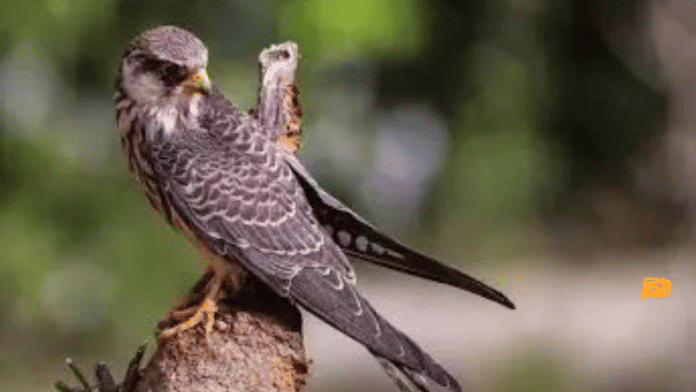New Delhi: An Amur Falcon, named Chiuluan 2 after a Manipur village, has returned to its home in Russia following a 17,000-km journey that involved a stopover in India’s Northeast and a non-stop flight over the Arabian Sea to reach South Africa, according to geo-tagging reports by the Wildlife Institute of India (WII).
The raptor, which has one of the longest migration routes in the world, is also representative of a hugely successful community conservation project in the Northeast.
“Chiuluan 2 is the first of our 17 geo-tagged birds that has gone beyond China and eastern Mongolia into Russia, which is the original place of these birds,” said Suresh Kumar, a WII biologist who is in charge of the Amur falcon tracking project. “It shows us that even after tracking these birds since 2013, we still have new things to learn about them.”
The geotagging reports were shared by the WII 27 May.
Unbelievable but true ! The little Amur Falcon, Chiuluan 2, has just completed his epic, jaw-dropping 17,000 km journey, traveling from Southeast Russia through India to Africa and back home . He demonstrated unmatched stamina and navigation skills, including a non-stop flight… https://t.co/z4EZAJRhiM pic.twitter.com/7Jw9Xzc2XT
— Supriya Sahu IAS (@supriyasahuias) May 30, 2025
The Amur Falcon tracking project started by the WII in 2013 was in response to large-scale hunting of these tiny birds in Manipur and Nagaland for food. After multiple community awareness projects led by the WII and local governments, the birds that descend over the Northeast India every year in winters are no longer hunted, but celebrated. The 180-degree turn in the conservation of these birds is visible in the response to their migration information shared by Kumar on the social media platform X, routinely.
“The little Amur Falcon, Chiuluan 2, has just completed his epic, jaw-dropping 17,000 km journey, traveling from Southeast Russia through India to Africa and back home,” posted IAS officer Supriya Sahu on X on 30 May. “He demonstrated unmatched stamina and navigation skills, including a non-stop flight over the Arabian Sea.”
The Amur falcons are a relatively unknown species of birds that originate near the Amur region of Russia, and spend almost eight months a year migrating between Russia and southern Africa, making a mandatory stopover in the Northeast in the states of Manipur and Nagaland. These birds fly nonstop over the Arabian Sea, covering stretches up to 3,000 km in one go, to cross from India to South Africa, where they stay for the winter months.
“Chiuluan 2 was tagged in early November 2024 when it was in India enroute to Africa. Now it’s back in Russia for the winters-once it returns to India again in November this year is when we’ll be able to say that it has completed one full migration circle,” explained Kumar.
Why Chiuluan 2 is a star migrant
Chiuluan 2 is named so because he is the second second bird to be geo-tagged in Chiuluan village in Manipur. When they caught him last November, he was a healthy sub-adult, and was fitted with a small solar-powered transmitter weighing merely 3.5 gms on his back. Now, he has become somewhat of a star in the geo-tagged Amur falcons community, traversing a distance longer than any other bird tracked before.
“While we knew that Amur falcons originate in the Amur River basin in Russia, none of the birds we had geo-tagged earlier actually went there for breeding,” said Kumar. “They remained in northern China, some 1,000 km north of Beijing.”

But even as the biologists watched, Chiuluan 2 left India on 30 April and flew across Myanmar, and along the length of China, over Mongolia, and finally crossed the border into Russia 27 May. This is where Kumar hypothesises that the bird will remain for the breeding season due to begin in the first week of June. It will be especially exciting for researchers because this is Chiuluan 2’s first breeding season, and when he returns in November, he might have his own progeny travelling with him.
Success of Falcon tracking project
Come November, Kumar is ready to tag three more falcons in the Northeast as part of the WII project that aims to study behavioural patterns of these birds. Talking about the success of the project, Kumar says he is confident they now know almost everything there is to know about Amur falcons.
“When we started the project we had so many questions in mind – how can they fly non-stop for so long? Why do they stop in northeast India despite hunting? How do they navigate their way back,” said Kumar. “Now though, we know the answers to it all.”
A paper published by the WII team in the Journal of Raptor Research in September 2024 outlines how the Northeast stopover is crucial for Amur falcons to refuel on their way to Africa. They time their arrival in September/October with termite season in the region, and feast on the protein-rich insects before their long non-stop flight over the seas. It is a well-oiled machine that predates anthropological factors like hunting.
“The falcons are a part of a beautiful natural system that is bigger than humans. They time their arrival with the end of the southwest monsoon in India, knowing that the termites emerge at the time,” said Kumar. “Additionally, they also help manage the termite population in Northeast India because without them the numbers would be in billions.”
However, Kumar is also worried about how factors like erratic monsoons and climate change could affect this well-oiled machine. With rainfall patterns changing across the world, it could have an adverse impact on termite populations, and thus on the diet of Amur falcons.
“These are all natural systems that have been in place for centuries, but with a constantly changing climate, I wonder how the Amur falcons will cope. Will this bring a change to their migration strategy? Will these wonderfully adaptable birds be able to cope with climate change?” Kumar wondered.
(Edited by Ajeet Tiwari)
Also Read: Siberia to Mozambique via Manipur, how the Amur falcons traverse the world in search of warmth







What a journey! Here’s wishing Chiuluan 2 longer journeys. Keep amazing!